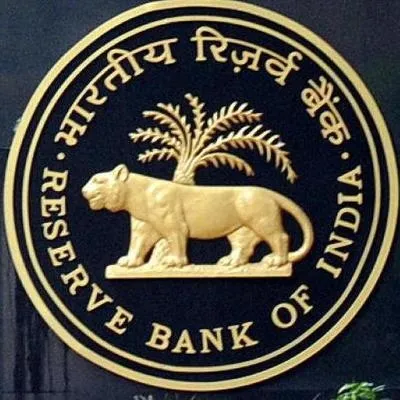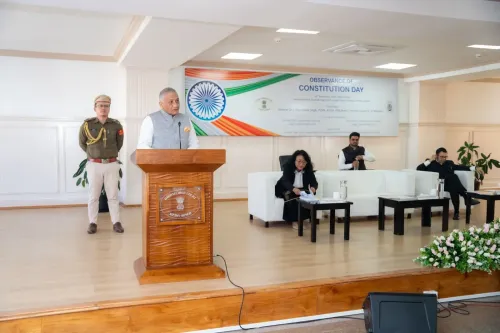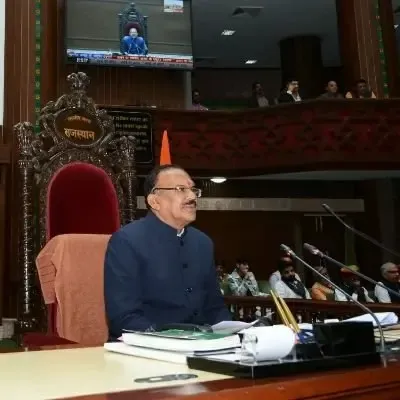Are RBI's Growth and Inflation Forecasts Based on Strong Data?

Synopsis
Key Takeaways
- The RBI's forecasts are based on robust econometric analysis and current economic data.
- Monetary policy decisions are influenced by transmission lags.
- Stakeholder consultations are crucial for accurate forecasting.
- Improving data quality is a priority for the Ministry of Statistics.
- New methodologies will enhance the accuracy of indices like CPI and IIP.
Mumbai, Nov 26 (NationPress) The Reserve Bank of India (RBI) has articulated its forecasts regarding inflation and growth in the Indian economy, underscoring that these projections stem from a meticulous blend of robust econometric studies, current economic conditions, and forward-thinking sectoral insights, as stated by Deputy Governor Poonam Gupta on Thursday.
During a Pre-release Consultative Workshop focused on the Base Revision of the Consumer Price Index (CPI), Gross Domestic Product (GDP), and Index of Industrial Production (IIP) that was organized by the Ministry of Statistics and Programme Implementation, she emphasized that recent analyses demonstrate that the RBI's inflation and growth predictions have remained impartial in relation to actual results.
Gupta noted that within the framework of flexible inflation targeting, monetary policy decisions are subject to recognized transmission lags that influence output and inflation across multiple quarters, making it crucial for policymakers to adopt a forward-looking stance. As a result, the Monetary Policy Committee (MPC) offers projections for inflation and growth up to four quarters at each of its bi-monthly meetings.
Nevertheless, she acknowledged that some forecasts may prove inaccurate during times of significant uncertainty and unpredictable shocks, a phenomenon observed globally. The challenge of forecasting inflation in India is further exacerbated by the outdated weight of food in the CPI basket and the erratic nature of food prices, she mentioned.
Gupta further highlighted that to enhance the accuracy of forecasts, the RBI is recalibrating its models to place greater reliance on recent and pertinent data while also expanding stakeholder consultations, which include comprehensive workshops with professional forecasters.
She also pointed out the importance of reducing forecast errors while avoiding systematic directional bias. Recent evaluations indicate that the MPC's inflation and growth forecasts have maintained objectivity in relation to actual outcomes.
Prior to each policy meeting, the RBI engages in extensive discussions with industry players, financial markets, banks, NBFCs, analysts, and economists to gather real-time insights on economic outlook. Continuous interaction with the National Statistics Office also aids in refining the bank’s forecasting methodologies, she added.
During the event, Saurabh Garg, Secretary of Statistics and Programme Implementation, stated that the government is committed to fortifying the National Statistical System, focusing on principles such as timeliness, increased frequency, granularity, coverage, use of modern technology, optimization of administrative data, harmonization of diverse datasets, and improved dissemination.
This function was held to inform key stakeholders about the intended base revision of GDP, CPI, and IIP in anticipation of the release of the new series next year.
Technical presentations from senior ministry officials provided insights into enhancements in data sources, methodologies, and compilation techniques concerning GDP, CPI, and IIP. Among the significant updates to the GDP 2022-23 series, it was announced that activity-wise turnover data from the Management & Administration Form will be employed to categorize activities for multi-activity enterprises in the Non-Financial Private Corporations (NFPC) sector.
GST data will be utilized to validate the framework of private corporations and the regional distribution of Gross Value Added (GVA) across industries. GVA estimates for the unincorporated sector will be compiled using industry-specific productivity data from the Annual Survey of Unincorporated Sector Enterprises (ASUSE) alongside corresponding workforce estimates from the Periodic Labour Force Survey (PLFS). With the availability of annual results from these surveys, estimates will be generated annually for the unincorporated sector in the new series, moving away from the indicator-based extrapolation method used in the existing series.
In the proposed alterations to the CPI, the ministry noted improvements in coverage concerning markets, towns, and items, the adoption of the Classification of Individual Consumption by Purpose (COICOP) 2018, refinements in index compilation methodology, the inclusion of new data sources such as administrative and online data, the application of state-of-the-art technology, and more precise data dissemination.
The primary changes and enhancements in the base-year revision of the Index of Industrial Production (IIP) emphasize expanding coverage, improving data quality, and better aligning the index with the evolving industrial framework through a comprehensive review of the existing item basket, reporting units, the replacement of inactive factories with operational units, and improved identification and categorization of items not classified elsewhere. The Ministry of Statistics and Programme Implementation is also addressing methodological challenges and data availability to compile chain-based indices and seasonally adjusted IIP series consistent with international best practices.









